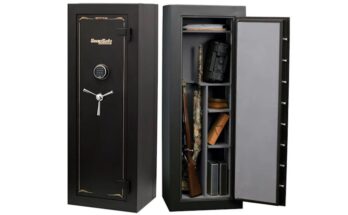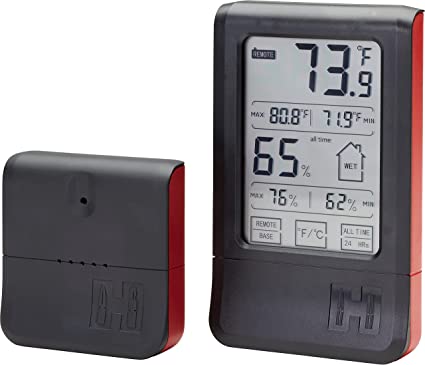A gun safe’s fire resistance depends on its specific design and construction. Most quality models offer certified fire protection for a limited time.
Determining whether your gun safe will endure a fire hinges on the materials used and the resistance rating it has been given. Gun safes designed to withstand fire typically incorporate layers of fire-resistant materials that can protect their contents for various time spans, usually anywhere from 30 minutes to a few hours at specified temperatures.
The fireproof rating, usually expressed in terms of temperature and duration the safe can withstand fire exposure, is crucial when selecting a safe if you’re concerned about potential fire damage. It’s essential to check the manufacturer’s specifications to gauge the level of protection each safe provides. Investing in a well-constructed gun safe with a proven track record of fire resistance gives you the security of knowing your firearms and valuables have a higher chance of surviving a blaze.
Not All Safes Are Created Equal
Imagine your prized possessions guarded by a fortress. Not just any fortress, but one forged with care and strong materials. That’s what you expect from a gun safe, especially during a fire. But remember, not all safes are equal in their line of defense against the blazing fury.
Material Matters
The first line of defense in a gun safe’s ability to withstand fire is its material. A safe’s endurance depends on what it’s made of. Quality steel can resist high temperatures, keeping the contents cooler for longer.
- Gauge of steel: Thicker means more protection.
- Fireboard layers: Multiple layers increase fire resistance.
- Inner shell materials: Materials like ceramic or concrete bolster fireproofing.
Select a safe with a high Underwriters Laboratories (UL) fireproof rating for best results.
Construction And Craftsmanship
How a safe is built affects its survival in a fire. The details in its construction dictate its strength. Safes with continuous welds offer more resilience than those with spot welding.
Key construction features include:
| Feature | Benefit |
|---|---|
| Seamless Welds | Prevents heat entry |
| Palusol Heat Seal | Expands to block heat and smoke |
| Reinforced Door | Limits warping under extreme heat |
Choose a safe built with precision and expertise for robust fire defense.
Understanding Fire Ratings
Picture this: a blaze engulfs your home with your prized possessions inside. Among them is your gun safe. Will it withstand the inferno? The answer lies in the safe’s fire rating, essentially a measure of protection it provides against extreme heat and flames. Let’s unravel the mystery behind these ratings and what they actually mean for your valuables during a fire.
Rating Systems ExplainedRating Systems Explained
Fire ratings for gun safes are not universal standards set in stone. Different agencies and laboratories conduct tests to determine how well a safe can protect its contents from heat. A common rating you might encounter is expressed in a format like “1-hour/1700°F“.
This means the safe can maintain an internal temperature less than a specified limit, usually around 350°F, for one hour at an external temperature of 1700°F. Here’s a quick breakdown:
| Rating (Hours) | External Temperature (°F) | Max Internal Temperature (°F) |
|---|---|---|
| 1/2 | 1550 | 350 |
| 1 | 1700 | 350 |
| 2 | 1850 | 350 |
Common Misconceptions
Many believe a higher fire rating means better overall protection. This isn’t always true. Fire ratings are specific to temperature and duration only, not the safe’s ability to withstand burglary or other disaster scenarios. Furthermore, not all testing standards are alike. A safe’s fire rating might change based on:
- The type of test conducted
- The specific temperature curve during testing
- How evenly the heat is applied
Another common misconception is that any gun safe will protect your documents or digital media. In reality, these items require safes with more stringent internal temperature thresholds, often lower than 150°F and 85% humidity.
Performance In Real-world Scenarios
Gauging the real-world performance of gun safes during fires provides critical insights into their reliability. Owners need confidence that their valuables will survive extreme conditions. We explore the experiences of actual users and documented cases to shed light on this vital safety aspect.
Anecdotal Evidence
Individual stories often paint a vivid picture of product performance. These accounts offer a glimpse into various outcomes based on fire intensity, duration, and safe construction. Some key highlights include:
- Safes withstanding temperatures above their rating for short periods.
- Differences in content conditions post-fire based on safe placement.
- Heat seals expanding effectively to keep out smoke and fire.
Testimonials And Case Studies
Detailed evaluations and real-life incidents offer valuable insights. Here are a few examples:
| Case Study | Fire Details | Safe Performance |
|---|---|---|
| Home Fire in Texas | 45 minutes at 1400°F | Interior intact, minor exterior damage |
| Office Fire in California | 1 hour at 1200°F | Some smoke seepage, contents secured |
| Wildfire Encounter | 30 minutes exposure to high flames | Complete protection, no interior damage |
These testimonials uphold the manufacturers’ claims to an extent. Expected performance often aligns with advertised ratings, stressing the importance of choosing a safe that meets fire-resistant standards.

Credit: www.amazon.com
Maintaining Your Safe
For gun safe owners, the question of durability in extreme conditions like fire is crucial. A well-maintained safe is more likely to withstand high temperatures. Routine care is key. Proper maintenance extends a safe’s life and performance during a fire. Let’s focus on two vital areas: regular inspections and upkeep of components.
Regular Inspections
Consistent checks help ensure safes stay in top condition. Look for signs of wear and tear. Address issues early. Here’s a checklist for inspections:
- Seals: Verify the integrity of fire seals.
- Locks: Test locking mechanisms for smooth operation.
- Bolts: Check if they engage and retract seamlessly.
Upkeep And Replacement Of Components
Over time, parts can degrade. Replace them to maintain performance. Focus on:
| Component | Importance | Replacement Indicator |
|---|---|---|
| Lock | Security | Difficult operation |
| Seal | Fire protection | Cracks or brittleness |
| Hinges | Door alignment | Squeaking or resistance |
Use manufacturer-recommended replacement parts. This ensures that your gun safe will last, even in a fire.
Choosing The Right Safe
Picture this: your valuable belongings, secured in a safe, cozy and hidden from prying eyes. But what if disaster strikes? Fires don’t play favorites, threatening everything in their path, including your safe. A robust safe can guard your treasures from flames, but only if you choose wisely. Let’s uncover how to pick a safe that can stand the heat.
Assessing Your Risk
Knowing your environment is key. If you dwell in an area with high fire incidents, you need a safe with top-notch fire ratings. Here’s what to look for:
- Fireproof Rating: This measures how well safes resist heat and for how long. Safes can protect from 30 minutes up to 2 hours.
- Seals: Robust seals expand in high heat, keeping flames and smoke out.
- Construction: Steel-walled safes offering thick layers can withstand higher temperatures.
Budget Vs. Security Needs
Balancing cost against safety, that’s the trick. More expensive doesn’t always mean better, but don’t skimp on quality. Here’s how to strike a balance:
| Budget | Security Features | Fire Rating |
|---|---|---|
| $ | Basic Lock, Minimum Thickness | 30 Min |
| $$ | Improved Locks, Better Materials | 1 Hour |
| $$$ | Top-tier Locks, Maximum Insulation | 2 Hours+ |
Decide what’s non-negotiable for you, and let that guide your wallet. Remember, some protection is better than none, especially when fire threatens.

Credit: www.amazon.com
Enhancements And Add-ons
One key concern for gun safe owners is how their safes will perform in the event of a fire. Understanding that a fire’s fury can be unforgiving, certain enhancements and add-ons can significantly bolster a safe’s fire resistance. This section will explore some of these crucial upgrades, ensuring that the treasures inside stand a better chance against the heat’s rage.
Fireproofing Upgrades
Not all gun safes offer equal protection in a blaze. Better fireproofing begins with thicker walls, superior fireboard layers, and expanded fire seals. When a fire strikes, these upgrades act as a fortress, shielding the contents from the inferno. Here are key features that enhance a safe’s endurance against fire:
- Multiple layers of fireboard: More layers mean more protection.
- Expandable door seals: These seals swell to block out heat and smoke.
- Reinforced steel: Thicker steel resists heat for longer periods.
Always check the fire rating; it tells you how long a safe can withstand certain temperatures.
Additional Security Features
While fire resistance is crucial, security features also receive an unequivocal nod. A robust gun safe not only has to withstand the sear of flames but also the prying hands of intruders. Upgraded locking mechanisms and rigorous build standards turn a safe into an unyielding vault. Consider the following for maximum security:
- Biometric locks: Quick access with unique fingerprints.
- Anti-tampering measures: They halt drilling and other break-in methods.
- Alarm integration: Connects to home security for alerts.
Quality locks and enhanced construction ensure peace of mind, whether facing fire or theft threats.

Credit: theintercept.com
Frequently Asked Questions For Will A Gun Safe Last In A Fire?
How Long Can Gun Safes Withstand Fire?
Gun safes are generally rated to withstand fire for a specific period, typically ranging from 30 minutes to 2 hours. The duration is determined by the safe’s construction, insulation materials, and fire rating.
What Fire Rating Should A Gun Safe Have?
Look for a gun safe with a fire rating of at least 1 hour at 1400°F. Safes with higher ratings offer greater protection for firearms during intense fires, but they tend to be more expensive.
Do Gun Safes Protect Ammunition In A Fire?
Yes, gun safes can protect ammunition in a fire. However, it is important that the safe has a high fire rating and that the ammunition is properly stored according to manufacturer’s guidelines.
Are All Gun Safes Fireproof?
Not all gun safes are fireproof. Quality and fire resistance vary widely, so it’s essential to check the fire rating and construction materials before purchasing.
Conclusion
Understanding the durability of gun safes in fires is essential for proper firearm protection. Selecting a safe with high fire-resistance ratings ensures long-lasting defense. Remember to consider the construction, insulation, and sealant qualities for maximum safeguarding. Safeguard your peace of mind by investing in a reliable gun safe designed to withstand the extreme heat of a fire.



